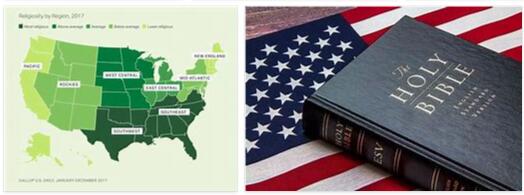The principle of absolute religious freedom, based on the strict and total separation of churches from the state, has not always prevailed in the United States; indeed, originally, the same colonies founded by the dissidents did not even know tolerance. And of the “pilgrim fathers” who emigrated to Massachusetts it could be said, paradoxically but not entirely wrongly, that they went to America to enjoy the faculty of worshiping God according to the dictates of their conscience as well as the other faculty of compelling all others to worship him in the same way. These concepts appear, moreover, in statements by Governor J. Winthrop the Elder, of Massachusetts, who applied them precisely in the case of R. Williams, who in 1636 founded, in the name of fuller religious freedom, the establishment of Providence, Rhode Island. Here, despite the dissent and fierce controversy between Williams himself and G. Fox, the Quakers were welcomed, persecuted in the other colonies and with particular fury in Massachusetts; and so also the Jews. Other states in which – having been founded for the purpose of offering asylum to dissidents – tolerance or religious freedom prevailed were Pennsylvania, Georgia, and Maryland until 1691. Instead the old colonies of Massachusetts Bay, Virginia, New Haven granted full civil and political rights only to members of one of the recognized churches.
The federal constitution, on the other hand, guarantees this religious freedom, in a form that refers to English precedents and which, implicitly, affirms the disinterest of the state in the forms of worship. The art. 6 says in fact that “no religious testwill ever be required as a condition of eligibility (qualification) for any office or office (trust) public dependent on the Confederation “. But later it was seen that with this measure the rights of individual citizens were protected, but not those of religious communities; and so the principle of separation found concrete expression in the 1st amendment of the constitution, for the which: “Congress will make no law concerning a religious establishment or prohibiting the free exercise of a religion.”
According to this principle, and also as a consequence of the tendency to split, which seems to be a characteristic of the confessions generated, directly or indirectly, by the Reformation, the United States is in all probability the country in which the greatest number of confessions or “lives.” Christian “denominations. In 1926 there were no less than 212 religious organizations with 232,154 institutes and 54,576,346 members. This figure, like the others indicated in the table below, concerns exclusively the “members” of the different churches: that is, both the participants in the communion, and those who are somehow regularly enrolled in one of the organizations, who are highly computed. different. This explains how Catholics, while still being a minority, nevertheless constitute the strongest group.
The Catholic Church now has a complex organization, with 15 ecclesiastical provinces, namely: Baltimore (1789; metropolitan since 1808), with suffragans Charleston (1820), Raleigh (1924), Richmond (1820), Austin (1870), Savannah (1850), Wheeling (1850), Wilmington (1868); Boston (1808; underground from 1875) with suffragans Burlington (1853), Fall River (1904), Hartford (1843), Manchester (1884), Portland, Maine (1853), Providence (1872), Springfield, Mass. (1870) ; Chicago (1843; underground from 1880), with suffragans Belleville (1887), Peoria (1875), Rockford (1908), Springfield (formerly Alton, 1857; changed name in 1923); Cincinnati (1821, metropolitan from 1850), with suffragans Cleveland (1847), Columbus (1868), Covington (1853), Detroit (1833), Fort Wayne (1857), Grand Rapids (1882), Indianopolis (formerly Vincennes, 1834; changed its name in 1898), Louisville (formerly Bardstown, 1808; changed its name in 1841), Nashville (1837), Toledo (1910); Dubuque (1837; underground from 1893), with suffragans Cheyenne (1887), Davenport (1881), Des Moines (1911), Grand Island (formerly Kearney, 1917, renamed in 1917), Lincoln (1887), Omaha (1885), Sioux City (1902); Philadelphia (1808; underground from 1875) with suffragans Altoona (1901), Erie (1853), Harrisburg (1868), Pittsburg (1843), Scranton (1868); Milwaukee (1843; underground from 1875), with suffragans La Crosse (1868), Green Bay (1868), Sault Ste Marie and Marquette (1857), Superior (1995); New Orleans (1793; subway from 1850) with suffragans Alexandria, Louisiana (formerly Natchez, 1853; changed name in 1910), Lafayette (1918), Little Rock (1843), Mobile (1829), Natchez (1837); New York (1808; subway from 1850) with suffragans Albany (1847), Brooklyn (1853), Buffalo (1847), Newark (1853), Ogdensburg (1872), Rochester (1868), Syracuse (1886), Trenton (1881), Portland, Oregon (formerly Oregon City, 1846; subway from 1850; changed name in 1928) with suffragans Baker City (1903), Boise City (1893), Great Falls (1904), Helena (1884), Seattle (formerly Nesqualles, 1907; changed name in 1907); Spokane (1913); San Francisco (1853), with suffragans Los Angeles-San Diego (1922), Monterey-Fresno (1922), formerly Monterey-Los Angeles (1850), Reno (1931), Sacramento (1886), Salt Lake (1891); St Louis (1826, metropolitan from 1847) with suffragans Concordia (1887), Kansas City (1880), Leavenworth (1877), St Joseph (1868), Wichita (1887); St Paul, Minnesota (1850; subway from 1888) with suffragans Bismarck (1909), Crookston (1909), Duluth (1889), Fargo (formerly Janestown, 1809; changed name in 1907), Rapid City (formerly Lead, 1902; changed name in 1930), Saint Cloud (1889), Sioux Falls (1889), Winona (1889) ; Santa Fe (1850; metropolitan from 1875), with suffragans Denver (1887), El Paso (1914), Tucson (1897); San Antonio (1874; underground from 1926), with suffragans Amarillo (1926), Corpus Christi (1912), Dallas (1890), Galveston (1847), Oklahoma and Tulsa (1905 and 1930). In addition, two ordinaries for Ruthenian Catholics, and the apostolic vicariate of Alaska.
Although there is no diplomatic relationship between the Holy See and the United States government, since 1893 there has been an apostolic delegate based in Washington. Great is the development of the Catholic religion in the United States from the end of the nineteenth century to today. There are 109 bishops, 31,108 priests (of which 21,378 belong to the secular clergy, 9730 to the regular), 12,720 parishes, 5667 mission stations and 197 seminaries, in which 22,629 seminarians are educated. There are 7490 parochial schools with 2,212,260 pupils; secondary or middle schools 1151, with 195,821 pupils; academies (high schools) for girls 658; finally, there are 196 high schools and universities with many tens of thousands of students.
